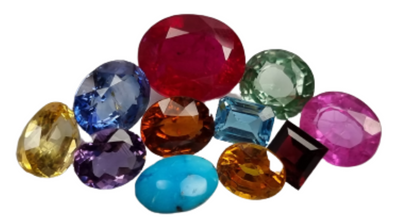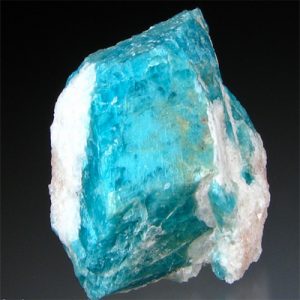Microcline: Gemstone Information
Microcline is belongs to Potash feldspar, alkali feldspar, K-feldspar. Amazonite is sometimes called amazon stone.
It is the common potassium feldspar in pegmatites where it takes the place of orthoclase. It can form the largest known crystals of any mineral (in a pegmatite in Kareliya, Russia, a microcline mass weighing over 2000 tons showed the form of a single crystal!). Microcline is also common in metamorphic rocks in gneisses and in sedimentary rocks in arkoses and conglomerates.
Notable deposits are found in Italy, Norway, Madagascar, Namibia, Zimbabwe, India, Russia, Brazil, Australia, Canada and the USA. Amazonite localities include USA (Colorado, California, Montana, Pennsylvania, Virgina–Amelia County, deep, blue-green, translucent), Canada (Ontario–Renfrew and Parry Sound districts and Quebec–Kipawa), Brazil, India (Kashmir district and elsewhere), Kenya, Tanzania, Madagascar (Anjanabonoina, Andina, Immody and Mahabe), Namibia and South Africa.
Russia the biggest gem amazonite deposits in the world are located in an area 1 km2 at Ploskaya Gora and Parus mountain, 80 km east from Lovozero, Kola Peninsula (there are more then ten pegmatite veins from 10 to 300-m long and from 0.5 to 30 m thick), also in Russia relatively large quantities of amazonite used as gem rock has come from pegmatite masses near Miass in the Ilmen range of the southern Ural mountains, Afghanistan at Madan Shar, Kabul Province in small deep blue-green, semi-translucent crystals and Australia (Broken Hill, New South Wales – also in semi translucent masses). Green microcline is reported from various localities in Brazil.
Appearance
Opaque to translucent, rarely transparent. Simple and polysynthetic twinning are ubiquitous and perthitic intergrowth with albite, extremely common. Reflections from incipient cleavages give polished surfaces a
shimmering effect.
Luster: Vitreous
Color: Commonly white to pale yellow or salmon, also may be blue to green in the microcline variety amazonite. It should be noted that although nearly all green potassium feldspar is microcline, much microcline, as well as most orthoclase, is commonly white, flesh- or salmon-pink.
Microcline: Unveiling the Beauty and Benefits of a Gemstone Classic
Microcline, a mesmerizing member of the feldspar mineral group, enchants with its distinctive coloration and remarkable properties. Renowned for its striking hues and diverse applications, microcline holds a special place in the world of gemstones. In this article, we explore the origins, characteristics, and benefits of microcline, shedding light on its allure and significance.
Origins and Formation
Microcline, deriving its name from the Greek words “micros” meaning small and “klinos” meaning inclination, is a potassium-rich variety of feldspar. It typically forms in igneous rocks such as granite and pegmatite veins, where it crystallizes from molten magma under specific temperature and pressure conditions. Microcline’s formation process imbues it with unique properties and color variations, ranging from pale greens to vibrant blues and pinks.
Physical and Optical Properties
One of microcline’s defining characteristics is its distinctive crystal habit, often occurring as prismatic crystals with a characteristic cross-hatch twinning pattern known as “Carlsbad twinning.” This twinning gives microcline crystals a unique appearance, enhancing their aesthetic appeal. Microcline exhibits a vitreous to pearly luster and typically displays translucent to opaque transparency, depending on its composition and impurities.
Microcline’s coloration varies widely, with green being the most common hue due to traces of chromium or vanadium. However, it can also occur in shades of blue, pink, white, and even yellow. This diverse color palette makes microcline highly sought after for use in jewelry and lapidary arts, where its vibrant hues add a touch of elegance and sophistication to various designs.
Metaphysical and Healing Properties
In addition to its visual appeal, microcline is revered for its metaphysical and healing properties, believed to resonate with energies of balance, harmony, and emotional stability. It is often associated with the heart and throat chakras, facilitating communication, self-expression, and emotional healing.
Microcline is thought to promote inner peace, calmness, and compassion, helping individuals overcome feelings of anxiety, stress, and negativity. It is also believed to enhance creativity, intuition, and spiritual awareness, making it a valuable tool for meditation, visualization, and spiritual growth.
In the realm of physical healing, microcline is said to support overall well-being and vitality, aiding in the treatment of disorders related to the heart, throat, and respiratory system. It is also believed to strengthen the immune system, balance hormonal function, and promote detoxification, fostering a sense of holistic wellness and rejuvenation.
Uses and Applications
Microcline’s captivating beauty and metaphysical properties make it a versatile gemstone with a wide range of uses and applications. In the jewelry industry, microcline is prized for its vibrant colors and durability, making it suitable for use in various types of jewelry such as rings, earrings, pendants, and bracelets. Its hardness and resistance to scratching ensure that microcline jewelry retains its beauty and luster even with regular wear.
Beyond jewelry, microcline is also utilized in decorative objects, lapidary arts, and architectural features due to its aesthetic appeal and durability. It is often cut and polished into cabochons, beads, and ornamental carvings, showcasing its natural beauty and unique color variations. In architecture, microcline may be used as a decorative stone in countertops, flooring, and wall cladding, adding a touch of elegance and sophistication to interior spaces.
Care and Maintenance
To preserve its beauty and integrity, microcline jewelry should be handled with care and cleaned regularly using mild soap and water. Avoid exposing microcline to harsh chemicals or abrasive cleaners, as these may damage its surface and affect its luster. Store microcline jewelry separately from other gemstones to prevent scratching or abrasion, and avoid exposing it to prolonged sunlight or heat, as this may cause fading or discoloration over time.
Conclusion
Microcline stands as a gemstone of timeless beauty and profound significance, captivating hearts and minds with its vibrant colors and metaphysical properties. From its origins in the Earth’s crust to its diverse applications in jewelry, decorative arts, and healing practices, microcline continues to inspire and enchant individuals around the world.
Whether worn as a piece of jewelry, used as a meditation aid, or incorporated into architectural designs, microcline serves as a reminder of the inherent beauty and harmony present in the natural world. With its soothing energies and balancing properties, microcline invites us to embrace inner peace, creativity, and emotional healing, guiding us on a journey of self-discovery and transformation.





